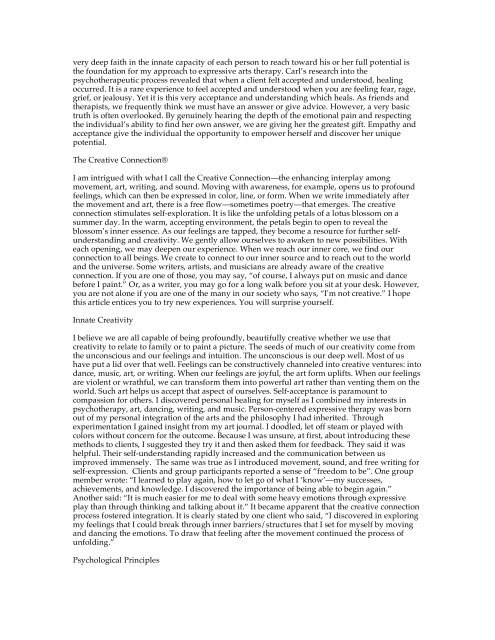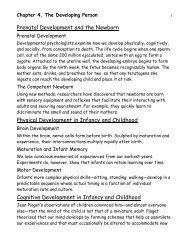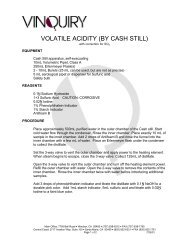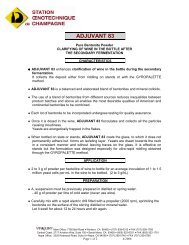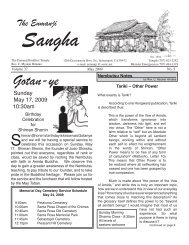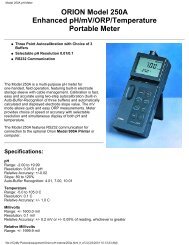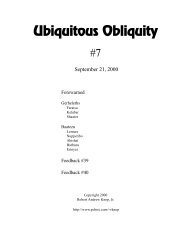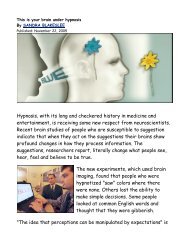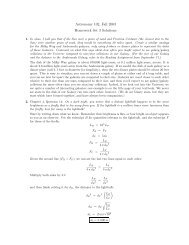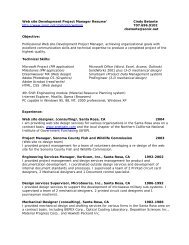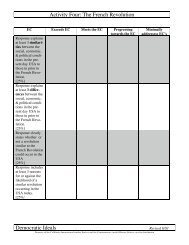Person-centered expressive arts therapy by natalie rogers - Sonic.net
Person-centered expressive arts therapy by natalie rogers - Sonic.net
Person-centered expressive arts therapy by natalie rogers - Sonic.net
Create successful ePaper yourself
Turn your PDF publications into a flip-book with our unique Google optimized e-Paper software.
very deep faith in the innate capacity of each person to reach toward his or her full potential is<br />
the foundation for my approach to <strong>expressive</strong> <strong>arts</strong> <strong>therapy</strong>. Carl’s research into the<br />
psychotherapeutic process revealed that when a client felt accepted and understood, healing<br />
occurred. It is a rare experience to feel accepted and understood when you are feeling fear, rage,<br />
grief, or jealousy. Yet it is this very acceptance and understanding which heals. As friends and<br />
therapists, we frequently think we must have an answer or give advice. However, a very basic<br />
truth is often overlooked. By genuinely hearing the depth of the emotional pain and respecting<br />
the individual’s ability to find her own answer, we are giving her the greatest gift. Empathy and<br />
acceptance give the individual the opportunity to empower herself and discover her unique<br />
potential.<br />
The Creative Connection®<br />
I am intrigued with what I call the Creative Connection—the enhancing interplay among<br />
movement, art, writing, and sound. Moving with awareness, for example, opens us to profound<br />
feelings, which can then be expressed in color, line, or form. When we write immediately after<br />
the movement and art, there is a free flow—sometimes poetry—that emerges. The creative<br />
connection stimulates self-exploration. It is like the unfolding petals of a lotus blossom on a<br />
summer day. In the warm, accepting environment, the petals begin to open to reveal the<br />
blossom’s inner essence. As our feelings are tapped, they become a resource for further selfunderstanding<br />
and creativity. We gently allow ourselves to awaken to new possibilities. With<br />
each opening, we may deepen our experience. When we reach our inner core, we find our<br />
connection to all beings. We create to connect to our inner source and to reach out to the world<br />
and the universe. Some writers, artists, and musicians are already aware of the creative<br />
connection. If you are one of those, you may say, “of course, I always put on music and dance<br />
before I paint.” Or, as a writer, you may go for a long walk before you sit at your desk. However,<br />
you are not alone if you are one of the many in our society who says, “I'm not creative.” I hope<br />
this article entices you to try new experiences. You will surprise yourself.<br />
Innate Creativity<br />
I believe we are all capable of being profoundly, beautifully creative whether we use that<br />
creativity to relate to family or to paint a picture. The seeds of much of our creativity come from<br />
the unconscious and our feelings and intuition. The unconscious is our deep well. Most of us<br />
have put a lid over that well. Feelings can be constructively channeled into creative ventures: into<br />
dance, music, art, or writing. When our feelings are joyful, the art form uplifts. When our feelings<br />
are violent or wrathful, we can transform them into powerful art rather than venting them on the<br />
world. Such art helps us accept that aspect of ourselves. Self-acceptance is paramount to<br />
compassion for others. I discovered personal healing for myself as I combined my interests in<br />
psycho<strong>therapy</strong>, art, dancing, writing, and music. <strong>Person</strong>-<strong>centered</strong> <strong>expressive</strong> <strong>therapy</strong> was born<br />
out of my personal integration of the <strong>arts</strong> and the philosophy I had inherited. Through<br />
experimentation I gained insight from my art journal. I doodled, let off steam or played with<br />
colors without concern for the outcome. Because I was unsure, at first, about introducing these<br />
methods to clients, I suggested they try it and then asked them for feedback. They said it was<br />
helpful. Their self-understanding rapidly increased and the communication between us<br />
improved immensely. The same was true as I introduced movement, sound, and free writing for<br />
self-expression. Clients and group participants reported a sense of “freedom to be”. One group<br />
member wrote: “I learned to play again, how to let go of what I ‘know’—my successes,<br />
achievements, and knowledge. I discovered the importance of being able to begin again.”<br />
Another said: “It is much easier for me to deal with some heavy emotions through <strong>expressive</strong><br />
play than through thinking and talking about it.” It became apparent that the creative connection<br />
process fostered integration. It is clearly stated <strong>by</strong> one client who said, “I discovered in exploring<br />
my feelings that I could break through inner barriers/structures that I set for myself <strong>by</strong> moving<br />
and dancing the emotions. To draw that feeling after the movement continued the process of<br />
unfolding.”<br />
Psychological Principles


